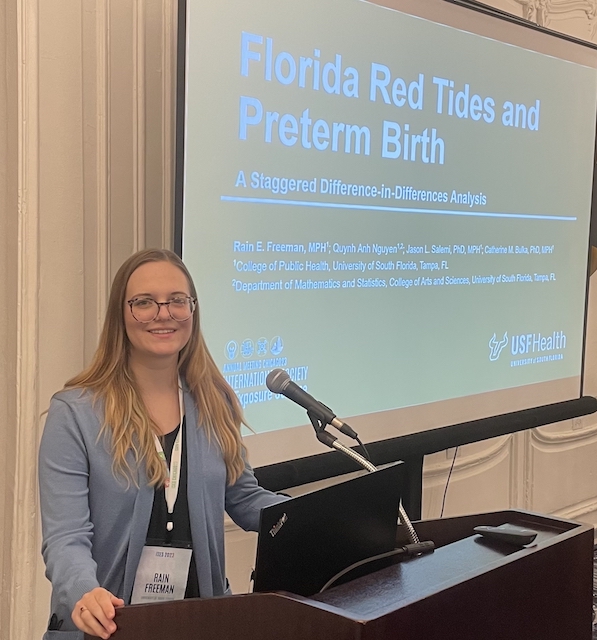COPH PhD student presents first-of-its-kind research on red tide exposure and pregnancy outcomes
Rain Freeman, a USF College of Public Health (COPH) PhD student concentrating in epidemiology, recently presented research about the effects of red tide on preterm birth at the International Society of Exposure Science (ISES) conference held in Chicago in August.
She conducted the research, “Florida Red Tides and Preterm Birth,” along with COPH professors Drs. Catherine Bulka and Jason Salemi, as well as USF College of Arts and Sciences student Quynh Anh Nguyen.

Freeman, whose interests lie in perinatal and pediatric health and life course epidemiology, said this is the first study to look at red tide and pregnancy outcomes in humans.
And its results were surprising.
“We had hypothesized that red tides would be associated with a higher risk of preterm birth,” Freeman explained. “We based this hypothesis on the environmental health literature regarding air pollution, which has consistently found a greater risk of preterm birth due to exposure to various air pollutants. We also know from animal studies that the toxins produced by red tide can cross the placental barrier and are toxic to developing embryos. Our hypothesis, however, was not supported by the null results of our analysis.”
A null result is a result without the expected outcome. Freeman says there could be several reasons for this unexpected discovery. For example. It’s possible, she said, that exposures to red tide during pregnancy are rare enough or not substantial enough to cause harm.
“Null results occur often in studies,” Freeman commented, “and they’re still important to report. For a few reasons, we believe that this topic needs more study.”
One reason is because the study used aggregated rather than individual-level data. “That is,” she said, “we cannot conclude that the same individuals experiencing higher red tide exposure are the same individuals who delivered their infants preterm.”
Secondly, she noted, the researchers based their exposure assessment on where pregnant people live in relation to the coastline when they gave birth. They did not account for factors such as how much time they spent outdoors, whether they had moved prior to giving birth and exactly how much algae were airborne. “We believe there is an urgent need to create more sophisticated measures of human exposure to red tide,” she said.
Freeman said she is working on turning the research into a manuscript that can be submitted to a peer-reviewed journal.
“I’m very intrigued by the topic of red tide and pregnancy and the distinct lack of information on exposure,” Freeman said. “Red tide is known to be harmful in terms of acute gastrointestinal and respiratory health in humans, yet it’s extremely unexplored in terms of long-term health impacts across many health outcomes. As this area of research becomes more solid, I hope the data will help clinicians and families better understand whether red tide exposure poses a risk to their health.”
Story by Donna Campisano, USF College of Public Health
